
Devil Demons & Satan
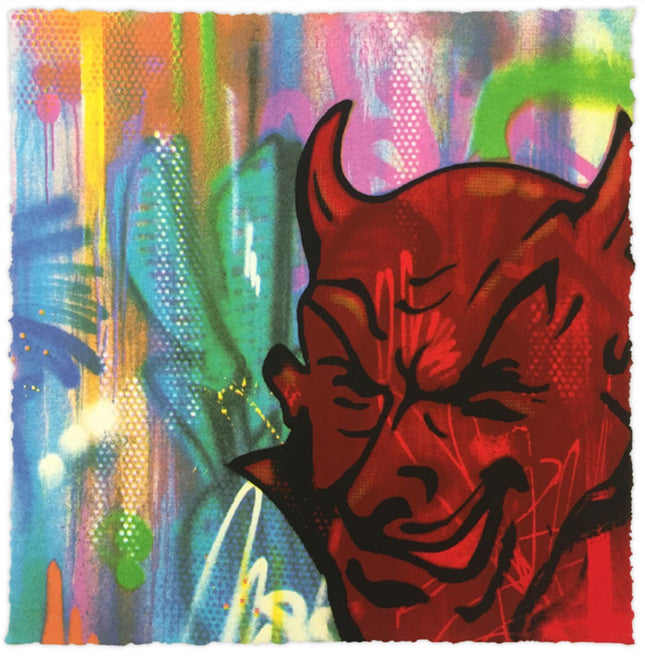
Risk Rock Third Rail PP Serigraph Print by Risk Rock
Third Rail PP Printers Proof Limited Edition Hand Pulled 7-Color Serigraph Print on 320gsm Fine Art Paper by Graffiti Pop Artist Risk Rock. PP Printers Proof 2015 Signed Limited Edition Artwork Size 24x24 Third Rail, 2015 Serigraph in colors on Coventry Rag Fine Art paper 24 x 24 inches (61 x 61 cm) (sheet) P.P. (aside from an edition of 50) Signed, numbered, and dated in pencil along lower edge. 7-Color Serigraph on 320gsm Fine Art Paper Size: 24 x 24 Inches Release: May 10, 2015 Run of: 50. This edition was originally sold with Risk's monograph Old Habits Die Hard. The book narrates Risk’s role as one of the pioneers of graffiti in Los Angeles and his aim to not only push the boundaries of his own art but also help elevate the graffiti movement to worldwide recognition. "Third Rail" by the celebrated graffiti pop artist Risk Rock is a striking embodiment of the vibrancy and subversive energy that define street art. Released on May 10, 2015, as a limited edition hand-pulled serigraph print, it encapsulates the artist's reputation for pushing visual boundaries. Each of the prints from this exclusive release is presented on premium 320gsm Coventry Rag Fine Art paper, with the dimensions of each sheet measuring 24 x 24 inches. This specific print, marked as a Printer's Proof (P.P.), stands apart from the main edition limited to 50, making it even more unique and sought after by collectors. Emphasized by a vivid seven-color palette, the serigraph method employed by Risk enhances the piece's textural depth and chromatic intensity, celebrating the graffiti art form's intrinsic link to urban culture. The artwork is not only signed by the artist but also numbered and dated along its lower edge, verifying its authenticity and connecting it directly to its creator's storied career. The image itself, a devilish, grinning face set against a backdrop of psychedelic colors and shapes, exudes the rebellious spirit inherent to the graffiti movement. This edition holds special significance as it was originally sold with Risk's monograph, "Old Habits Die Hard." The publication dives into Risk's influential role as one of the progenitors of the Los Angeles graffiti scene. His work and leadership helped catapult street art from its underground roots to a significant movement recognized worldwide. The monograph details Risk’s journey as an artist and his dedication to advancing not only his artistic expressions but also to contributing to the broader acceptance and appreciation of graffiti as a legitimate and powerful art form. Risk Rock's "Third Rail" stands as a potent representation of this transformative era in art, symbolizing the transition of graffiti from street corners to fine art galleries, and securing Risk’s legacy within the cultural tapestry of pop art, street art, and graffiti.
$979.99
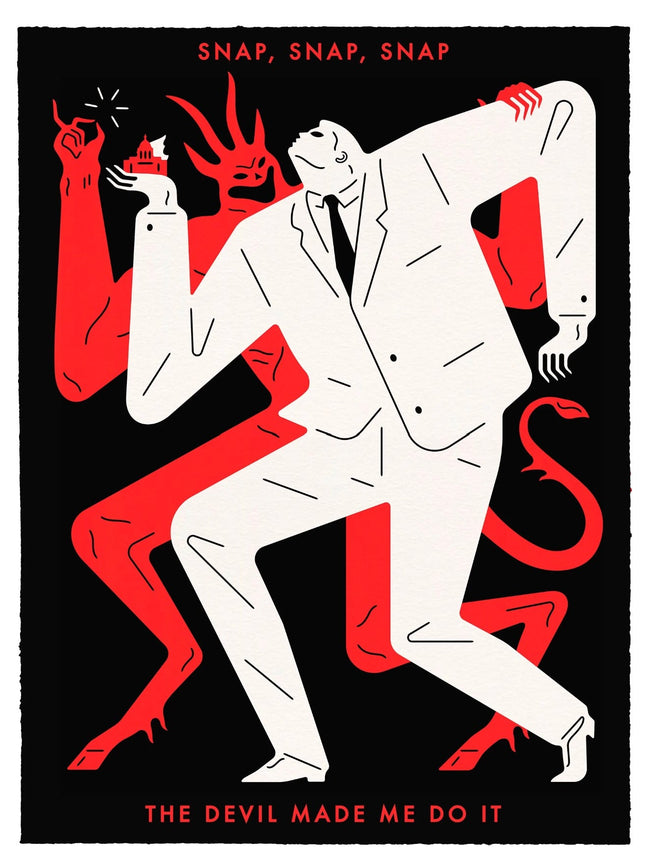
Cleon Peterson The Devil Made Me Do It Silkscreen Print by Cleon Peterson
The Devil Made Me Do It Hand-Pulled 2-Color Silkscreen Print on Hand Deckled 290gsm Coventry Rag Paper by Artist Cleon Peterson Limited Edition Pop Art Artwork. 2022 Signed & Numbered Limited Edition of 300 Artwork Size 18x24 "The TRUTH image ran in the New York Times right before the election in the opinion feature, What Have We Lost. The Devil Made Me Do It & Divided We Stand, United We Fall were both made on January 6th in response to the Faustian bargain that Trump and his accomplices made in designing the coup. Today, we find ourselves at a crossroads; now, more than ever, we must come together, take a stand, exercise our voices, and fight for Truth and Democracy. Hopefully, daylight will cast off this right-wing authoritarian spell. I see these posters as markers of a historical time and feel a duty within to share my views. We're all exhausted by politics, but we must embrace the moment and take action because the threat is fundamental; our democracy could be gone in the blink of an eye." - Cleon Peterson. Cleon Peterson's Stark Commentary in "The Devil Made Me Do It" In the stark dichotomy of black and red, Cleon Peterson's "The Devil Made Me Do It" delivers a powerful visual commentary on the socio-political climate surrounding the events of January 6th, marked by the infamous U.S. Capitol riots. This hand-pulled 2-color silkscreen print on hand-deckled 290gsm Coventry Rag Paper emerges as a piece of street pop art and a historical marker, capturing a moment of intense national upheaval. Art as a Reflection of Societal Turmoil Peterson's artwork, a limited edition of 300 signed and numbered pieces, transcends the traditional boundaries of pop art. It embodies the artist's response to a fraught political landscape, reacting to the tumultuous events that shook the foundations of American democracy. The imagery of a man seemingly dancing while overshadowed by demonic figures speaks to the "Faustian bargain," suggesting a dance with the devil that echoes the betrayals and manipulations of political figures and the public seduced by their rhetoric. The title, "The Devil Made Me Do It," offers an ironic twist on the age-old excuse for succumbing to temptations and making morally questionable choices. Peterson's choice to release these works as a direct response to political events positions the artwork within a tradition of artists who use their craft to document and critique the times they live in. The visual language used in this piece is reminiscent of street art's often aggressive and provocative style, meant to engage the public in public spaces. The Role of Street Pop Art in Political Discourse Cleon Peterson's work exemplifies the role of street pop art in political discourse. Street art has always had a voice in the political arena, often serving as a raw expression of the people, unfiltered and unmediated. Through his work, Peterson extends this tradition by creating a piece that is both a reaction to and reflection of the political unrest that has characterized recent times. With its bold, unapologetic lines and vibrant colors, silkscreen printing makes "The Devil Made Me Do It" a commanding presence. It is a testament to the artist's ability to distill complex political and social emotions into a single, impactful image. In the tradition of street pop art, which often involves taking art out of the galleries and into the streets, Peterson's piece is designed to resonate with a broad audience, its message clear and accessible to all who encounter it. "The Devil Made Me Do It" is more than just a piece of pop art; it is a visual essay on the state of contemporary politics, a call to action, and a reminder of the power of art to reflect and affect change. It is a bold statement within the discourse of street pop art and graffiti artwork, capturing a moment when the world watched as democracy appeared to hang in the balance. Cleon Peterson's voice, through his art, adds to the chorus of those who advocate for truth and democracy, and his work remains a powerful example of how art can engage with and influence the political landscape.
$687.99
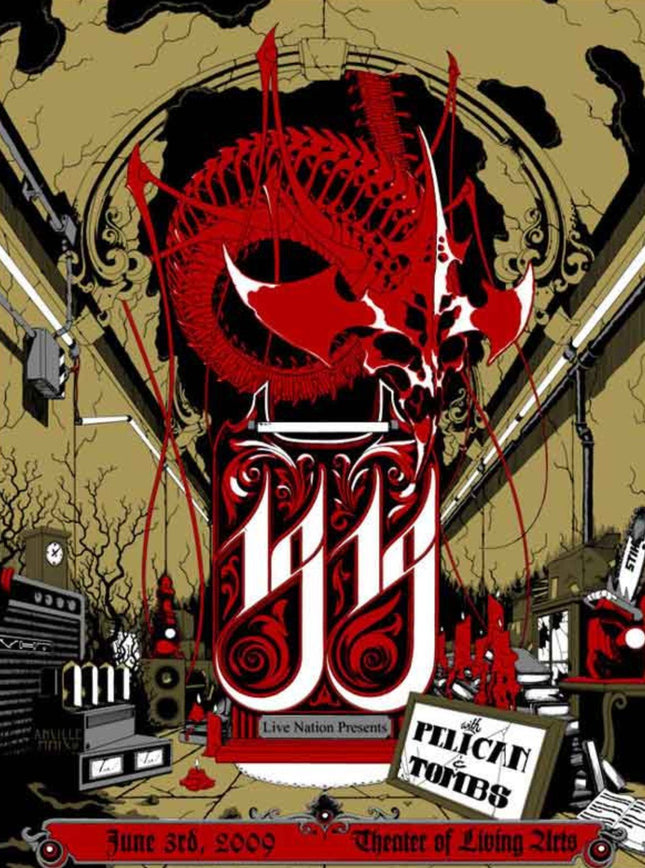
Justin Anville 1919 Pelican Tombs Pennsylvania 2009 Silkscreen Print by Justin Anville
1919- Pelican Tombs- Pennsylvania 2009 Music Limited Edition Gig Poster 4-Color Hand-Pulled Silkscreen Print Artwork on Fine Art Paper by Justin Anville. 2019 Signed & Numbered Limited Edition Gig Music Poster Artwork Size 18x24. 919, Pelican Tombs, Music, Event, Theatre of Living Arts, Philadelphia, Pennsylvania, June 3rd 2009, Live Nation The Synthesis of Music and Street Pop Art The convergence of music and visual arts often produces memorabilia that transcends the moment of its creation, embedding itself in the cultural fabric of a time and place. Such is the case with the limited edition gig poster for the event featuring "1919" and "Pelican Tombs" held at the Theatre of Living Arts in Philadelphia, Pennsylvania, on June 3rd, 2009. This striking piece of street pop art and graffiti artwork is a celebration of both the bands and the evocative power of graphic design within the realm of music. This limited edition gig poster is more than just a promotional tool; it is a collectible artwork that reflects the vibrancy and raw energy of the musical acts it represents. Created by the artist Justin Anville, the print is a four-color, hand-pulled silkscreen on fine art paper, a technique that lends the artwork a tactile quality that is both immediate and engaging. The choice of silkscreen printing, a favored method in both street art and pop art for its bold colors and sharp lines, allows the piece to stand out with a visual pop that mirrors the intensity of the live music experience. Visual Elements and Artistic Significance The artwork commands attention with its intricate design and contrasting color palette, which features a dominant red against a backdrop of more subdued tones. At the center, the stylized numerals "1919" are prominently displayed, intertwined with symbolic imagery that suggests a narrative extending beyond the bands' names. This typographic treatment is reminiscent of graffiti art, where letters become an integral part of the visual impact, often carrying meaning in their form as much as in their content. Cultural Imprint of the 2009 Event Poster Limited to a signed and numbered edition, the poster carries with it an aura of exclusivity. Measuring 18x24 inches, it is a sizable piece that was designed to be noticed, to be a talking point, and ultimately, to be remembered. As a piece of memorabilia, it serves as a timestamp, capturing the cultural zeitgeist of the late 2000s Philadelphia music scene, a period marked by a resurgence in indie and alternative genres. The inclusion of the Live Nation brand also signifies the commercial and mainstream acknowledgment of the genres and bands, hinting at their movement from the fringes into the spotlight. The Legacy of Gig Posters in Street Pop Art The significance of gig posters like this one extends beyond the night of the event itself. They are artifacts of cultural history, capturing the essence of musical movements and the artistic styles that accompany them. In the broader context of street pop art and graffiti artwork, gig posters are often the crossroads where music and visual art fans meet, share, and appreciate the interplay between these forms of expression. This particular poster, with its bold aesthetic and connection to a specific time and place, is a perfect illustration of how street art and music can come together to create something enduring. In the ever-evolving dialogue between music and visual arts, the 2009 limited edition gig poster for "1919" and "Pelican Tombs" stands as a testament to the power of this collaboration. It is not just a promotional item; it is a snapshot of a scene, a piece of street pop art, and a collectible that holds within its inks and paper the echoes of a night of music and the spirit of its time.
$238.00$167.00
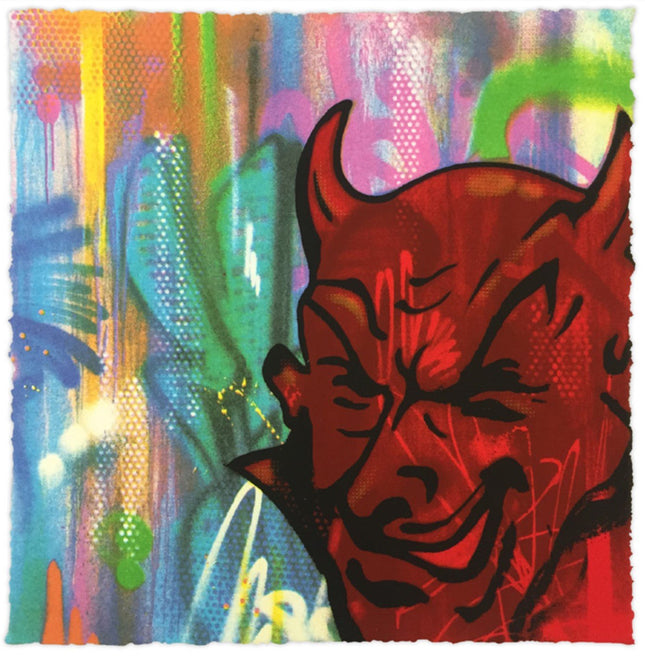
Risk Rock Third Rail Serigraph Print by Risk Rock
Third Rail Limited Edition Hand Pulled 7-Color Serigraph Print on 320gsm Fine Art Paper by Graffiti Pop Artist Risk Rock. 2015 Signed & Numbered Limited Edition of 50 Artwork Size 24x24 "Third Rail" emerges as a prominent piece within the oeuvre of Risk Rock, whose influence in the graffiti pop art scene has been memorable and groundbreaking. This 2015 masterpiece is part of a signed and numbered limited edition series of only 50, ensuring its exclusivity and appeal among art collectors and enthusiasts. Measuring 24x24 inches, the work is a testament to the artist's skill in hand-pulled serigraphy, boasting a dazzling array of seven colors on 320gsm fine art paper. This print vividly captures the essence of pop art, street art, and graffiti in one frame, showcasing Risk Rock's adeptness at melding color, texture, and urban symbolism. The piece pulsates with the life and rhythm of the streets, channeling the raw energy of graffiti culture into a pleasing art tableau. Each print from this series is a fragment of a larger narrative, a snapshot of the artist's journey through the concrete canvases of city walls and alleyways to the polished galleries of the art elite. The imagery Risk Rock employs is both iconic and provocative—a hallmark of true street art. His work transcends the typical, creating an evocative visual language that speaks to the viewer on multiple levels. By incorporating elements of risk and rebellion, which are as much a part of his identity as his moniker, the artist challenges perceptions and encourages a dialogue about the place and value of street art in contemporary society. Through "Third Rail," Risk Rock doesn't merely paint over the fabric of the urban landscape; he weaves himself into it, becoming an integral thread in the tapestry of modern art. His pieces are not just seen; they are experienced, invoking a visceral reaction as much as it is visual. For those fortunate enough to own a piece of this limited series, it's not just an acquisition of art; it's an immersion into the spirit and soul of a movement that has left an indelible mark on the world.
$734.99
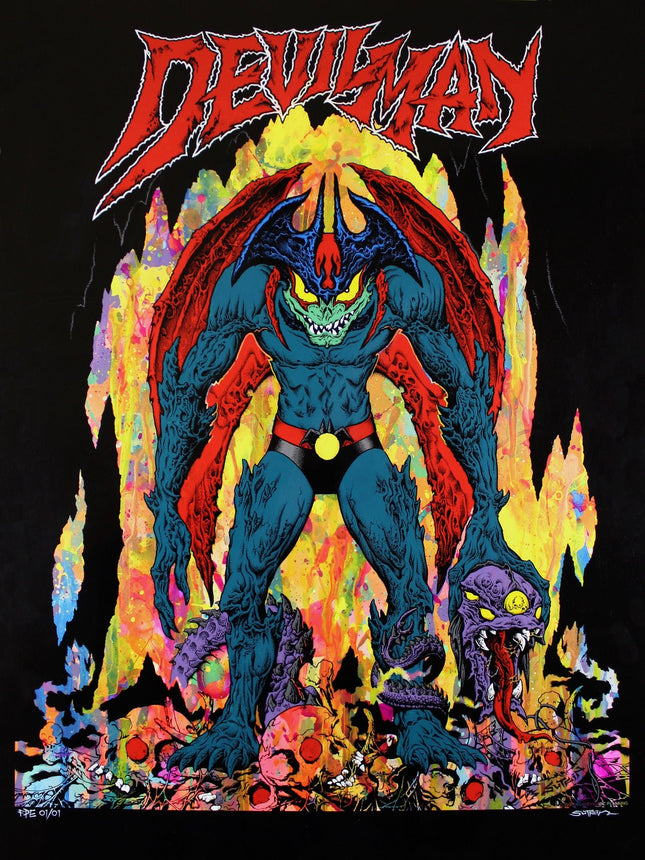
Mike Sutfin Devilman Silkscreen Print by Mike Sutfin
Devilman Limited Edition 9-Color Hand-Pulled Silkscreen Print on Fine Art Paper by Mike Sutfin, Graffiti Street Artist Modern Pop Art. 2015 Limited Edition of 300 Artwork measuring 18" x 24", these prints needed eight screens and nine colors to capture their vibrancy on the 100# c stock French Pop-Tone Berrylicious paper used, and the back view of the character is printed on the reverse side of the print. Mike Sutfin's Devilman: A Symphony of Color and Chaos The "Devilman" limited edition silkscreen print by Mike Sutfin is a formidable example of how street pop art and graffiti artwork can bring together vibrancy, intensity, and a touch of the macabre. This 2015 piece, a limited edition of 300, captures the essence of its subject matter through a stunning 9-color palette applied via eight screens onto 100# c stock French Pop-Tone Berrylicious paper. Measuring 18x24 inches, the artwork showcases Sutfin's mastery in a modern pop art context, providing a fiery representation of the titular character with a complexity that demands attention. The Artistic Process Behind Devil man's Creation The creation of "Devilman" is a testament to the meticulous silkscreen printing process. The requirement of 8 screens for the nine colors used in the piece illustrates the intricate layering process that imbues the artwork with depth and dynamism. The process is detailed, requiring precision and a keen eye for detail to ensure that each layer of color sits perfectly upon the last, building up to create the final arresting image. This technique, while traditional in its roots, is brought to life in a new way through Sutfin's skillful hands, blending the boundaries between street art and fine art. Interpreting Devilman: Street Pop Art Meets Mythology Sutfin's "Devilman" is more than a visual spectacle; it explores mythology, character design, and the eternal dance between good and evil. The figure stands amidst flames, a visual nod to the hellish realms often associated with devils and demons. Yet, the character is not merely a representation of evil. The complexity of the image, with its vibrant colors and detailed linework, suggests a narrative that goes beyond the binary of good versus evil. It speaks to the inner battles that rage within, the fiery potential for destruction and rebirth in every individual. The decision to print a back view of the character on the reverse side of the print adds a layer of depth to the artwork, inviting viewers to consider the many sides of the character – and themselves. This duality is a common theme in street pop art, where the surface image often belies a more profound story waiting to be uncovered by those who look closely enough. Mike Sutfin's "Devilman" is a powerful example of modern pop art's ability to combine traditional techniques with contemporary themes. The artwork stands as a beacon within the genre, showcasing how street pop art and graffiti can transcend their urban origins to enter the realm of collectible fine art. Through works like "Devilman," artists like Sutfin continue to push the boundaries of street art while also honoring the rich, colorful, and sometimes dark stories that have always been at the heart of human expression.
$245.00$172.00
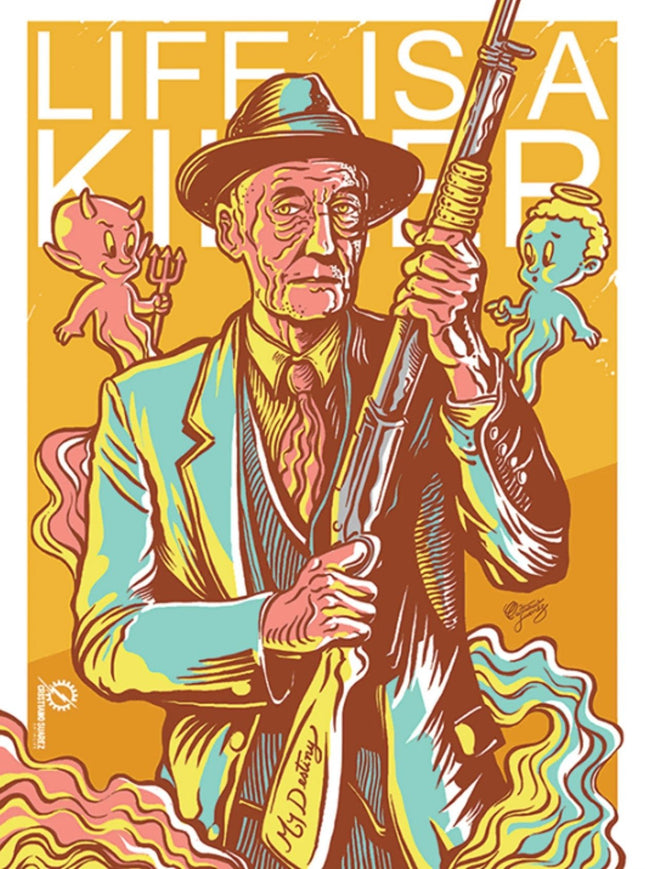
Cristiano Suarez Life is a Killer Silkscreen Print by Cristiano Suarez
Life is a Killer Limited Edition 3-Color Hand-Pulled Silkscreen Print on Fine Art Paper by Cristiano Suarez Graffiti Street Artist Modern Pop Art. Paying Homage to William S. Burroughs Screen Print Size: 18" x 24" City: Maceio, Brasi.
$129.00$90.00
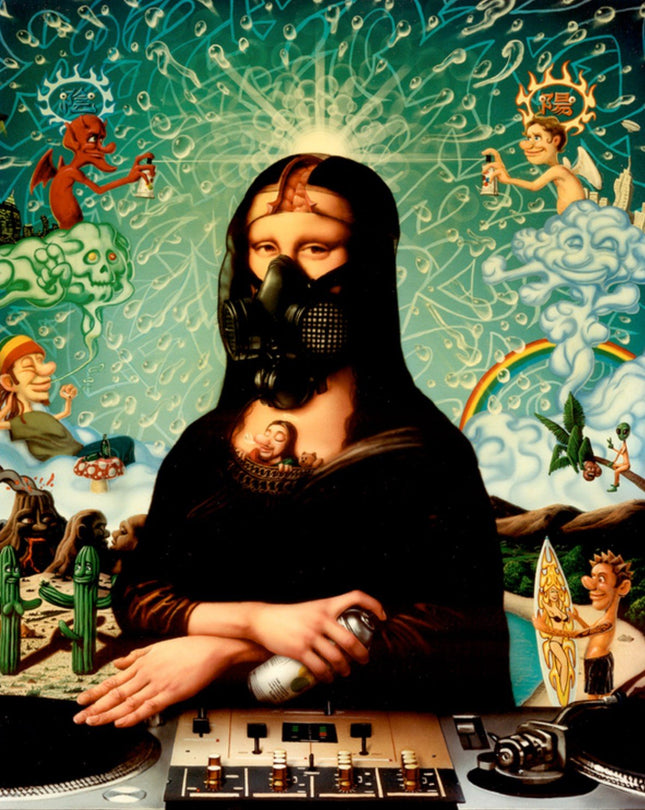
Naoto Hattori Sweet Dreams Giclee Print by Naoto Hattori
Sweet Dreams Artwork Giclee Limited Edition Surreal Print on 100% Cotton Rag Fine Art Paper by Pop Culture Graffiti Artist Naoto Hattori. SWEET DREAMS 20 x 24 inches (50.8 x 61 cm) High Quality Giclee Print on 100% Cotton Rag Fine Art Paper Signed and Numbered Edition of 150
$397.99
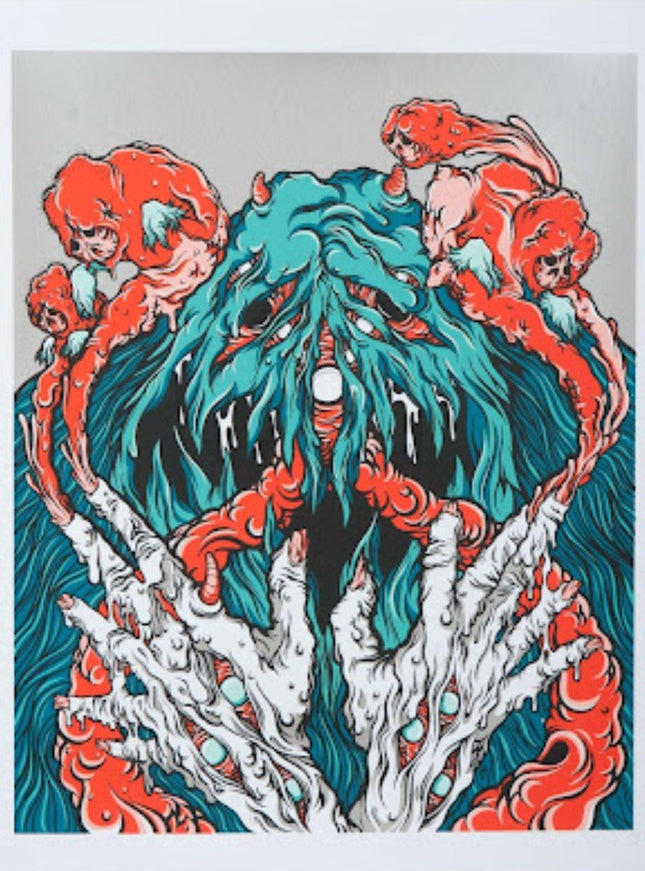
Scarecrowoven The Fiend Demon Fantasy Silkscreen Print by Scarecrowoven
The Fiend Demon Fantasy 7-Color Silver Metallic Hand-Pulled Limited Edition Silkscreen Print on Cream-Colored French Paper by Scarecrowoven Macabre Art Pop Artwork Artist. Printed on cold-press watercolor paper signed and numbered edition of 50. 18x24
$238.00$167.00









